American-based horsemanship experts Dan James and Warwick Schiller were two of eight Australians who tackled the 500-kilometre Gaucho Derby in Patagonia last month. The race challenged them in unexpected ways, but despite the tough and humbling ride they say it’s an experience that’s given them more than they ever imagined.
“It was pretty wild… adventure, torture, joy; they’re all words that come to mind,” says Dan James of Double Dan Horsemanship. He blames fellow Aussie horseman Warwick Schiller for the crazy idea. “It was Warwick that brought it up. I had him to thank him and to cuss all at the same time.”
The Gaucho Derby was inaugurated in 2020 and has been dubbed “the greatest test of horsemanship and wilderness skills on Earth”. Covering 500 kilometres through the mountains and pampas of Patagonia, the race generally spans eight to 10 days, and tests not only the riders’ skills on a horse – of which they ride many over the course of the race – but pushes their navigation skills to the limit and tests their physical endurance and ability to handle the wilderness.

“The Gaucho Derby is based
on the landscape, culture,
history and horses of Patagonia…”
The Gaucho Derby is based on the landscape, culture, history and horses of Patagonia and, of course, the gauchos themselves. Historically, gauchos were South American cowboys who traversed the pampas herding half-wild cattle that had escaped British, Dutch, French, and Portuguese traders in the mid-18th century. These days, they work on private estancias (estates), similar to that of the Aussie ringer – and culturally they are celebrated much like the Australian bush cattleman.
The idea to contest the Gaucho Derby came across Warwick’s desk two years ago when adventurer Stevie Delahunt was a guest on his podcast. “Stevie had raced both the Gaucho Derby and its 1,000-kilometre sister race, the Mongol Derby, in the Gobi Desert of Mongolia. My son Tyler and I had not long come back from riding camels for 300km in the Gobi Desert in the dead of the frigid Mongolian winter, and my crazy mind said if I could ride 300km on a camel in Mongolian winter, then I could easily ride a horse 500km in Patagonian summer. Right there on the podcast, I told Stevie I would do it.”
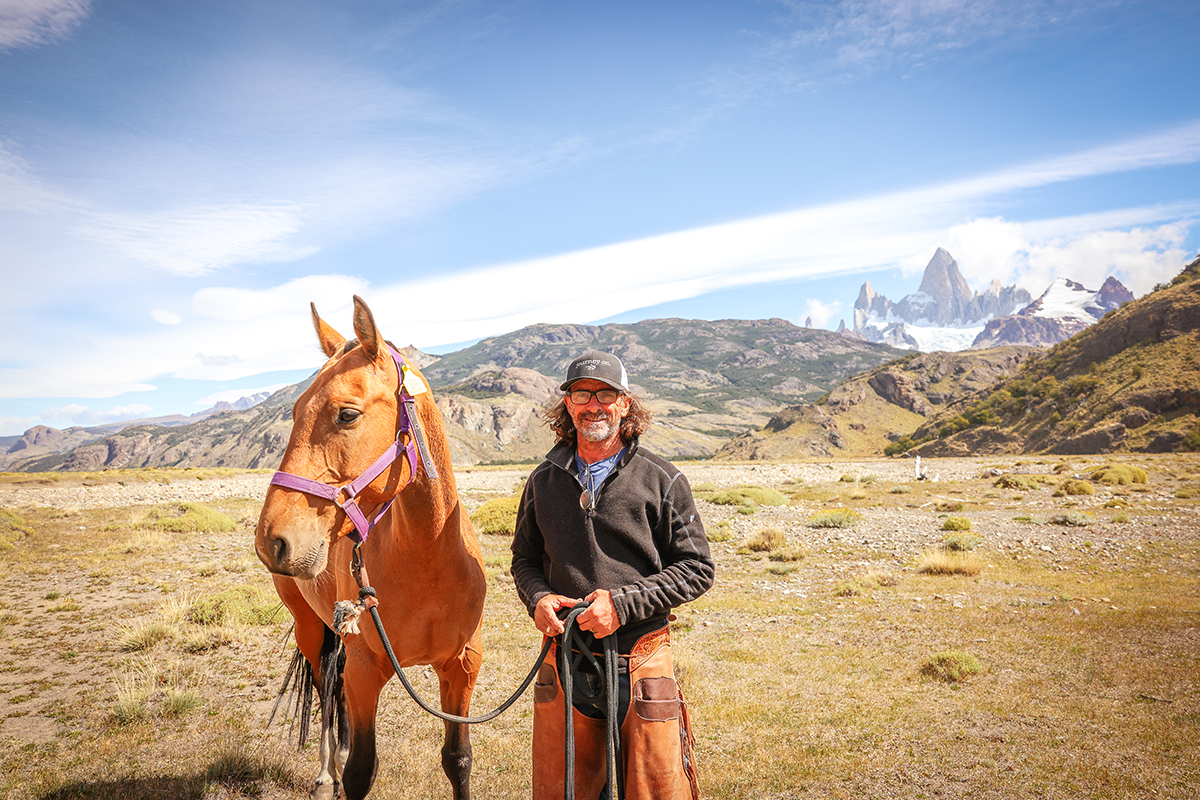
EXTENSIVE PREPARATION
Warwick’s preparation was extensive. In July 2022 he went to a boot camp in Oregon run by Stevie and her husband, Dylan, where they use their endurance horses to train people for both the Gaucho and Mongol Derbies. “I’d never ridden distance before and immediately had trouble with my feet going numb and pain in my knees,” explains Warwick. “Then, in February 2023, I went to Argentina to the Gaucho Derby Academy, which prepares people for the race. In October 2023, I went back to Stevie’s for another boot camp. This time, as Oregon was heading into winter, we wanted to test our rain and cold gear.”
Despite this preparation, Warwick felt his physical readiness for the race was lacking. “My knee was flaring up with osteoarthritis, and I had not been able to run, so I chose to focus on my core and immediately popped a considerable hernia,” he says. “Eventually, I settled on a calisthenics program that allowed me to get into some sort of shape without aggravating my problem spots. When I first went to Stevie’s boot camp, I found that riding distances made my thighs sore in the same places that they get when riding bareback, and so my riding preparation consisted of trotting and cantering bareback up and down the hills on our ranch in California.”
Two weeks before the Derby, Warwick went to Southern California with friend and fellow entrant, Kansas Carradine, where they competed in an endurance race on borrowed horses. “We did 50 miles (80km) one day and 30 miles (48km) the next, camped in our tents, and ate freeze-dried food in preparation for Patagonia. One night, it was -10°C, and our gear proved adequate. I was surprised that I could do squats the following day with no pain. The bareback riding was doing its trick, and we were ready.”
Dan entered later than Warwick and his preparation began around 12 months out. “America had been a bit too good to me,” he laughs, explaining how he had to lose weight to even make it to the start line. “Fully dressed in your helmet, boots, everything on and ready to ride, you can only be 185lb (84kg). My body weight, without any of that, was 176lb (80kg), so I had a small window and had to get my body weight down.
“The last three months I was running 25km a week and I was dragging battle ropes behind me just to try to get there. When I finally did the weigh-in I had to fast, and I made it in by the skin of my teeth. Before the race, I was 168lb (76kg). I weighed myself after coming home – and this is after probably putting on a pound or two after the race – and I was 164lb (74kg). I don’t think I’ve been that light for a long time.”

As Warwick explains, not only are the riders weighed fully dressed, but what they must carry to be self-sufficient during the race – tent, sleeping bag, mattress pad, food, camp stove, and emergency equipment – must also come in under 10kg. “Everything is weighed down to the gram before starting.”
Dan was a little underprepared in terms of his geographical knowledge, initially believing Patagonia was a country! “I later came to find out that it’s actually a region that runs through Chile and Argentina,” he laughs.
“Everything is weighed
down to the gram
before starting.”
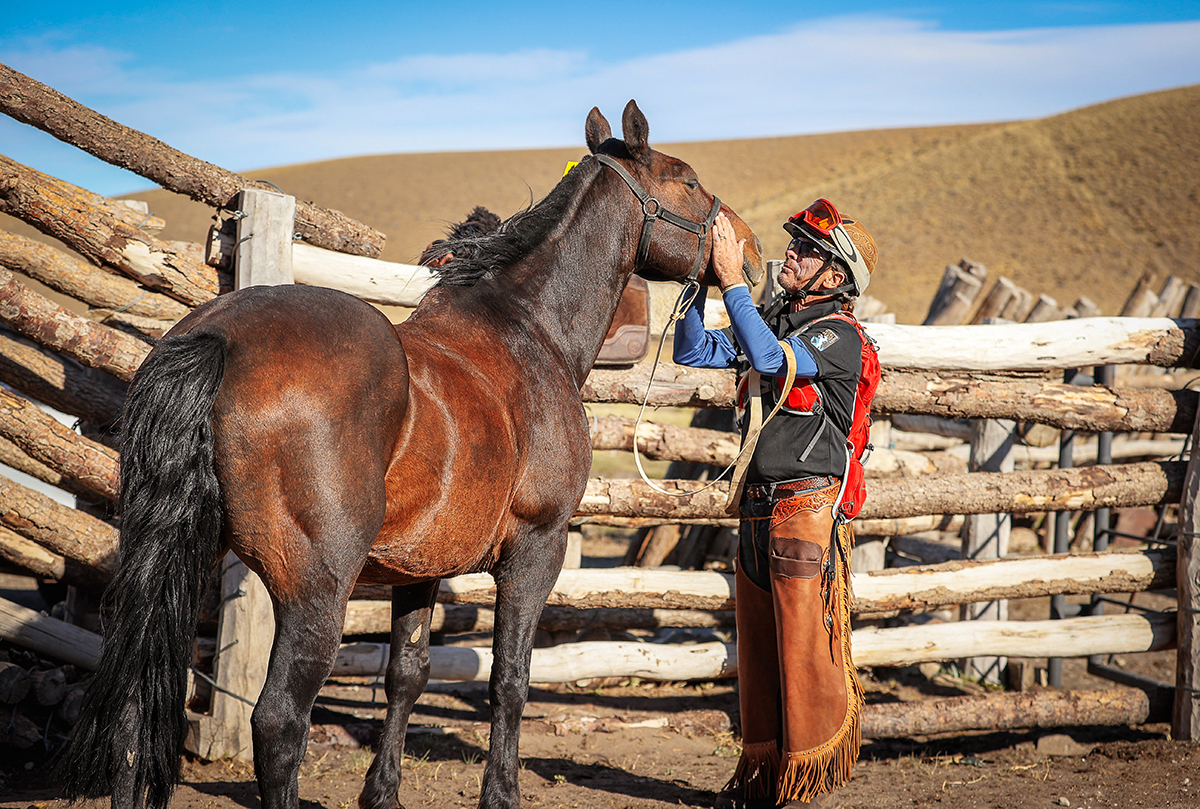
OFF & RACING
Following three days of on-site race preparation, it was time to race. “We had nearly 40 people at the start line and it was just utter chaos,” recalls Dan. “There were people falling off left right and centre… it was just crazy at the start line.
“The race has a lot of moving parts,” adds Warwick. “Of course, there’s the horse riding and horsemanship, which is intimidating. Then there’s the navigation required, as there is no marked route. You have to use GPS coordinates and topographical maps.”
On the first day, this navigation element caused Warwick a serious headache. “This race has a lot of unknowns, including fences. You’re riding through large stations (known as estancias). The fences are not marked on the map, and when you come to one you have to decide to go left or right to find a wire gate. You may go three or four miles in one direction only to have to turn around and ride back to your original position and try the other direction.”
On the first day, Warwick, Kansas and many others travelling together at the time ended up on the wrong side of a fence. “It cost us several hours of going in the wrong direction, so by the end of the first day we were camped with the back of the pack. It was not a huge concern, as my goal was to survive the race and make it to the finish line, not to beat anyone.”
Meanwhile, Dan had problems of his own that ultimately meant he wasn’t with Warwick during the great fence debacle of day one. “There was myself, Warwick, and a handful of others all in the lead, and my horse tripped… I had my GoPro on one of my jackets that was tethered to the saddle, and it fell off. I thought, ‘No way can I lose this on day one in the first 30 minutes.’”
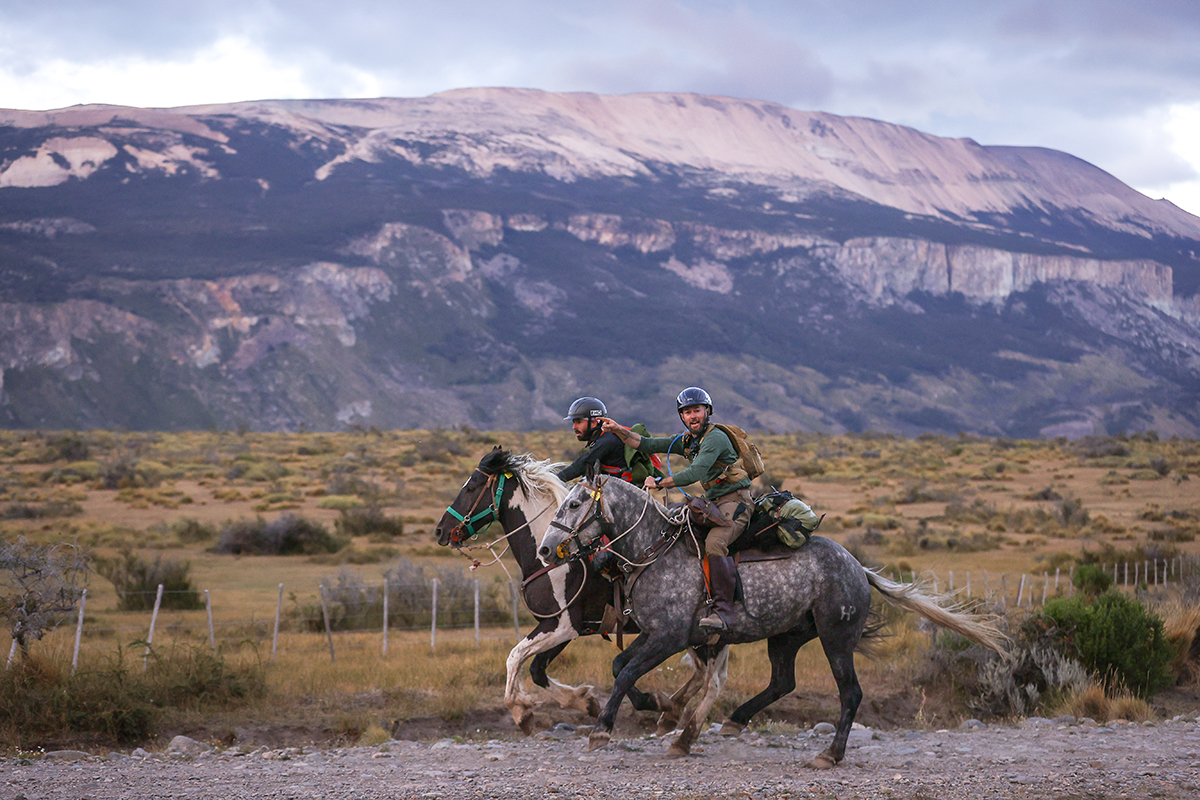
So Dan backtracked to look for his GoPro, and despite it being in the road of galloping horses he found it and resumed the race. “I was just getting back into it and then Elliot Holtzman, a friend from Texas who I was riding with, the back of his saddle – the part his equipment was strapped to – broke. We got to the first checkpoint, and we were literally the last two… that was humbling and demoralising all at the same time.”
By the next vet check, Dan and Elliot were back with the leaders following the fenced-related navigation issue experienced by several other competitors. “It’s just amazing how it could literally change in a matter of moments and hours from being where you’re at the tail to where you’re in the lead,” says Dan.
‘IF YOU WANT TO GO FAR, GO TOGETHER’
“The characters you meet along the way, it’s such an incredible group of people that come from so many different walks of life. One of the guys that we got to know was a French pharmacist… and we said, ‘how the hell did you end up doing this?’ Then you’ve got Will, the Australian ringer and helicopter pilot,” explains Dan of the diverse 39-rider field.
Warwick and Dan were two of eight Australians, with William Evert, Caity Kelly, Todd Russell, Lucinda Kyle, Hugh McMurtrie and Duncan Mclaughlin all taking part in this year’s race. Also along for the ride was Australian photographer Kathy Gabriel, who captured all the incredible photos in this article.
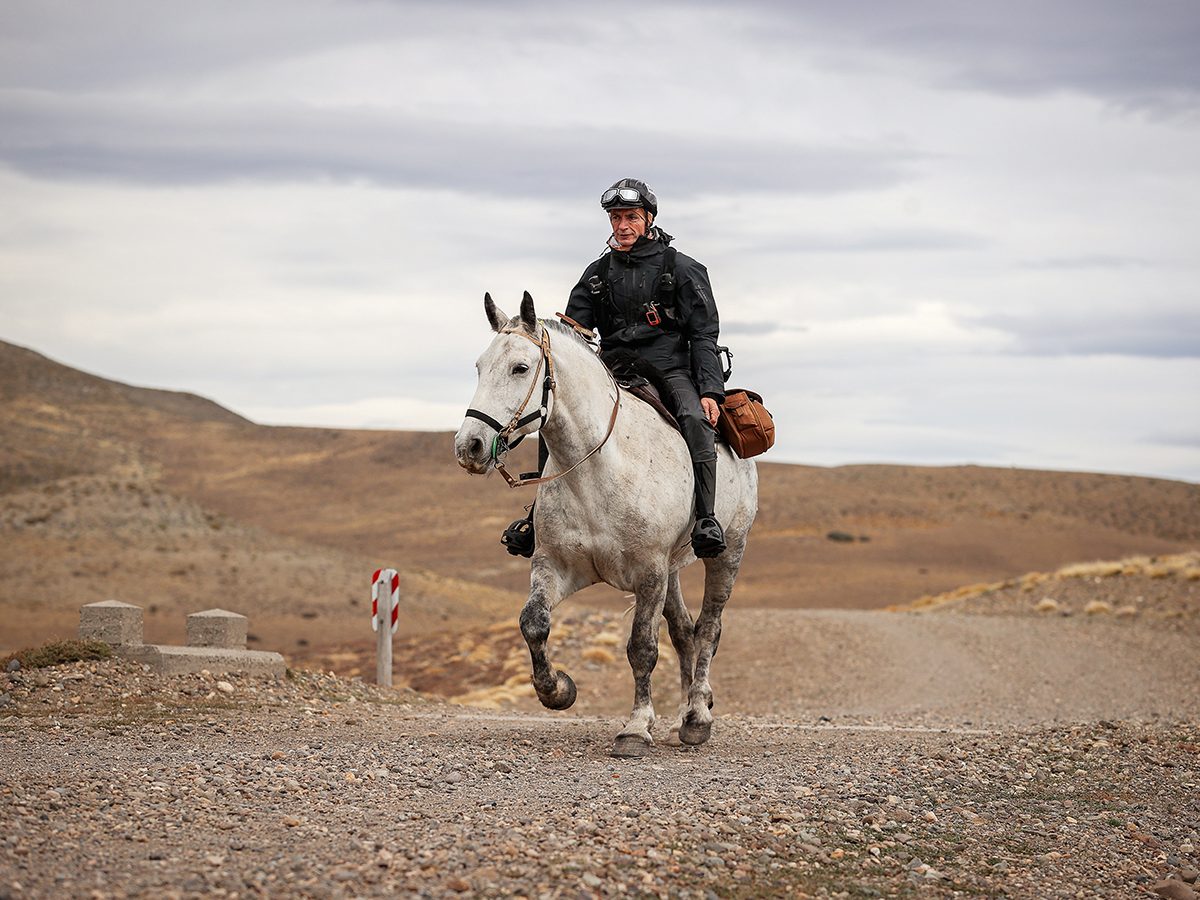

“It turned out that my best man at my wedding taught Will to fly helicopters,” says Dan. “Elliot and I ended up with Will and his partner Caity and it was great camaraderie. The four of us rode every single day together.” Will was no stranger to the challenge, being a veteran of the Mongol Derby, while Caity grew up in remote Australia around horses and has done everything from mustering to campdrafting and eventing.

“Navigation was not my strong suit, but people tend to form groups and ride together, so there’s always someone to bounce ideas off,” explains Warwick, who ended up spending much of the race with Kansas, and also Todd Russell, a Thoroughbred stud manager and young horse educator from Bowral.
Kansas, the daughter of actor David Carradine, had been a trick rider and trick roper in the phenomenal Cavalia show and had toured the world with the full-on circus-style mix of equestrian and performing arts extravaganza. She was a late entrant in the race, securing a spot just two months out when another entrant withdrew.
“When it comes time to get your horse, names are drawn from a hat,” explains Warwick. It just so happened that Kansas and I drew a bonded pair as our first horses. I spent the first three days with my horse’s head buried in Kansas’ horse’s flank. I couldn’t get him to take the lead or even go up beside her, so I talked to the back of her head for three days.”
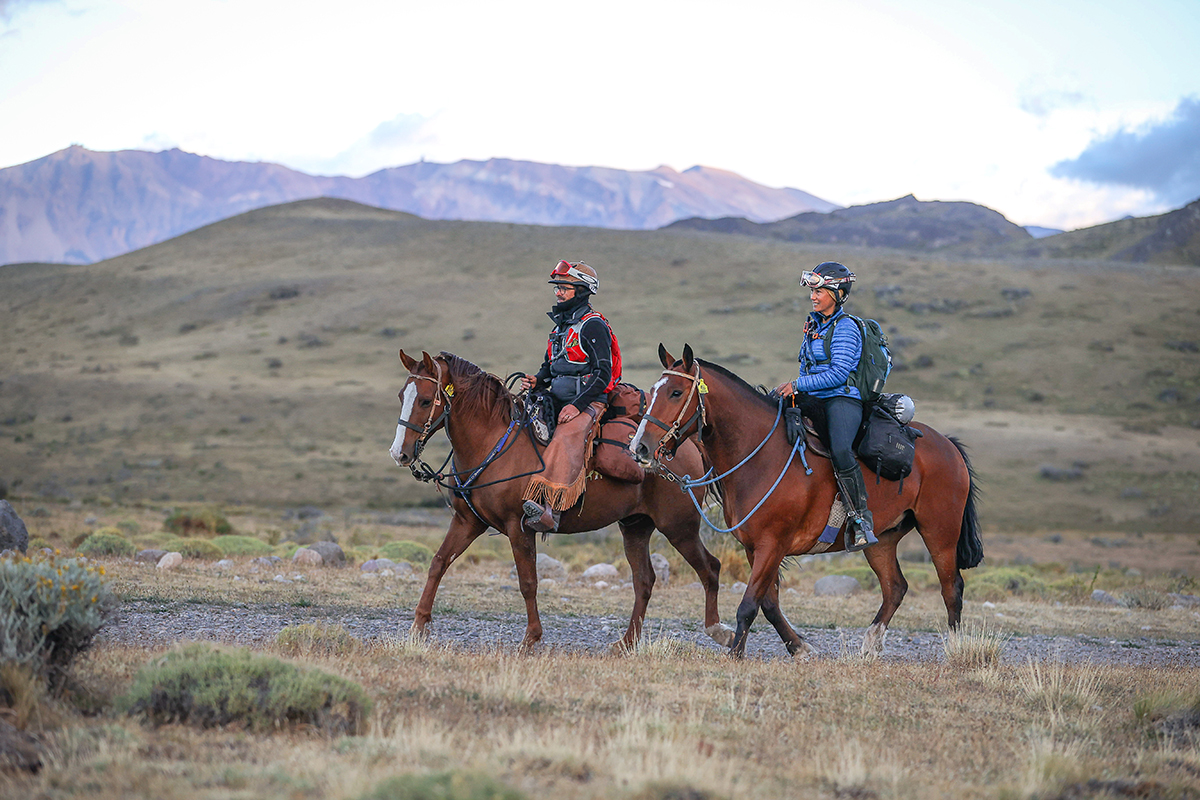
Warwick saw Dan and Elliot at the start line but did not see them again until five days later, such was the vastness of the landscape and the variety of routes that could be taken. During that time, Dan, Elliot, Will and Caity actually led the race for a while, until they had to come to the aid of another competitor. While there are support staff, it’s often the case that other riders are your nearest point of help and as a rider you could also be a first responder in the event of an accident.
At one stage, Dan’s group had to rescue a competitor’s horse that bucked off a cliff. Dan says it was the scariest thing he’s ever seen – and that’s saying something for someone who has spent a lifetime around horses and was head stockman on a 1,000,000-acre cattle station in the Kimberly, Western Australia. Fortunately, horse and rider were unharmed in the incident.
“It was great to see humanity in people,” says Dan. “They just have a common thing that they want to achieve, and it really points out the importance of community, because the difference that it made if you were riding with mates…. in terms of how you could encourage, kick someone up the arse, and help them throughout the day… that really stood out. There’s that saying that goes ‘if you want to go fast, go alone; if you want to go far, go together’. And that was really evident.”
THE HORSES
The Gaucho Derby horses were hired from local estancias and gauchos. Dan believes the money that the gauchos make by hiring out their personal horses was almost double their wages for the year, and so the race has become a big event for the local economy.

Welfare is, of course, a critical concern. The race requires 12 vet checks. Event founder Tom Morgan asserts that organisers would rather nobody wins than someone wins by pushing too hard. “Riders seen making bad decisions, riding too fast across difficult terrain or not presenting horses in great condition will get penalties or be disqualified,” he says. Riders of course swap horses at various intervals, depending on the stage of the race and the conditions – the horses aren’t overworked, and riders are kept on their toes.
“They are a cross between an endurance horse and a mountain goat,” explains Warwick when asked what the horses were like. He says they were tricky to catch and generally preferred to avoid human interaction, but once you were in the saddle they knew they had a job to do – so long as you could stay on initially, you were probably in for a reasonable ride.
“They’re tricky to get on, and the fact that they’re not used to wearing packs doesn’t help. I saw many competitors get bucked off as they mounted, but once you got through that initial stage, they were the most sure-footed horses I’ve ever ridden,” says Warwick. “They would willingly canter across things I wouldn’t lead my horse across. Every day, they showed us what was possible, and our perception of what a horse is capable of was stretched.”
“I had two horses that I honestly inquired about buying them and bringing them home,” enthuses Dan. “You would have ridden them into war; they would go anywhere that you pointed them. Huge hearts, huge engines, and yet still super careful. And then some of them… I would have in the heat of the moment maybe shot them and used them for dingo bait,” he jokes. One of those was no doubt the steed that dumped Dan and left him to walk home. “Having to walk home dragging your pride and your ego with you is a pretty good humbling experience,” he laughs.
Some of the riders definitely had a little bad luck with the horses they drew, in particular Aussie Todd Russell. “We said if there was a John Wayne Award, he could have got it. That poor bastard, he must have got bucked off every day… but he just kept climbing back on. He ended up with stitches in his arm and even on the last morning of the last day, he saddled his horse… it ran off bucking, he got on it, and it bucked him off again.”

An equine stud manager and young horse educator, Todd has been part of the Thoroughbred industry in Australia for the past 15 years – and hence he’s certainly not a novice rider. Dan tells that story with no disrespect to Todd’s horsemanship, as some of the horses were seriously challenging – evidenced by the fact Dan himself was bucked off.
Some who came to grief were not as fortunate as Dan and Todd. Fellow Aussie Hugh McMurtrie – a beef cattle farmer who was no stranger to the challenge given he’d already completed the Mongol Derby in 2022 – had a fall that punctured a lung. It left him unable to fly post-race and he was forced to remain in hospital there for some time afterwards.

In addition, the equipment they were required to carry made dealing with difficult horses even harder. “Some of them, the moment you put a foot in the stirrup, they’re gone. They’re ready to run off. It’s one thing climbing on with nothing strapped to you and no other equipment, but you start climbing on with a bunch of equipment and you feel like a fat kid trying to climb on a cupcake! says Dan.
“A lot of them were trained to neck-rein but some would only turn one direction… and then in addition to that you either basically got a horse that would lead or a horse that would follow. If it was a horse that would only follow, you’d spend an entire day ridding up someone’s arse – just as Warwick learned over the first three days All of that being said, when you got one of the good horses, they were incredible and they changed my entire opinion on where and what a horse could go over, like they were insane.”
THE CHALLENGES
“Before the race began, I thought the biblical Patagonian wind, along with rain and cold, while riding a horse ten hours a day, sleeping in a tent, and wearing the same clothes without bathing for 10 days would be the challenge, but none of those bothered me in the slightest,” says Warwick.

Dan echoes the same sentiment. “In retrospect, we got really lucky with the weather.” Having said that, he adds that he’s never experienced wind that strong. “It lived up to its reputation. The wind on the first day, literally three horses and riders in front of me got blown laterally into a fence from the wind while walking. You couldn’t undo the chinstrap on your helmet and not hang on to it, because it’d blow your helmet off your head.”
Warwick was surprised that in a physical sense, his body held up remarkably well. “I didn’t get sore, I didn’t get rubbed, I didn’t get tired, my feet didn’t go numb, my knees didn’t hurt. I’m still puzzled about how much the body can adapt to take care of us when we need it to.”
Dan largely escaped unscathed, although there probably are fragments of his dignity left strewn across the pampas. “It was bloody brutal… short of you being an ultra-endurance rider I don’t think that anything else could really prepare you for it. It got to the point on day five where I had to ask one of the medics at a vet check for help… I had my pants around my ankles in front of about 30 other people while she was patching up my arse. Yeah, it’ll wear a hole in you!

“Other things that ended up being challenging were elements such as being demoralised navigating… going through a certain section and coming out thinking ‘how did I get that so wrong?’ That was a kick in the teeth,” says Dan, adding that the terrain was also far tougher than he expected.
“You see the terrain and it’s just out of this world. It was more challenging than I expected. It’s by far the roughest, most extreme terrain that I’ve not only ever ridden a horse through, but ever even walked on!”
And while the way the horses handled the terrain was mind-blowing for Dan, he says there was one section of the race that he feels needs revisiting.
“There was a section of the race leading into what they called the ‘Plateau of Death’, through these extreme rock bogs on what used to be an old volcanic area. I’ve never seen country like it. I just felt that just because horses have gotten through it, doesn’t mean that you should ride them through it. For me, I would want to see that section of the race revisited to help people navigate through it or reroute them.” In response, the event has said it reviews the route and feedback every year and makes changes for the future.
However, it was ultimately the mental strain that challenged both Warwick and Dan more than anything else – and this was something they weren’t expecting nor prepared for. Part of that mental strain was the realisation that their loved ones at home were subject to a fair amount of stress during the ordeal.
As someone who considers himself a strict rule follower and lists a pet peeve as having those rules change around him, he found conflicting directions from organisers during the race a challenge. “I’m not saying their job is easy. In fact, it would be a logistical nightmare, but I’m a rule follower. When every person in an authority position tells me something different than the last one, it takes an emotional toll on me,” he explains.
The race had live tracking via the riders’ GPS trackers so those at home could follow their progress. “My breaking point came about as a result of my GPS tracker failing. I’d been messaging HQ for three days, telling them my tracker would not charge.” At this point Warwick was with Kansas and therefore there was a working tracker between them, so he felt safe knowing HQ at least knew their location.
“At some point, I checked my phone to see what time it was in California and realised that it was 6am. My wife, who suffers from anxiety, would have just woken up. I knew she would be checking the live tracking, and upon seeing that my tracker was not visible would start guessing as to whether I was alive or dead.”

The thought of his wife’s distress was Warwick’s breaking point. “When I arrived at the next vet station, I lost it. I broke down, wept, and quite possibly called the organisers some names that I’m not proud of. One of the medics there consoled me, got my wife’s number, and messaged her on the satellite phone to say I was okay.”
Dan says he found this same aspect of the race challenging. When he was bucked off and had to walk home, his family could only see that his tracker was sent back and then remained stationary all day. Without any outward communication to let them know “his dumb arse got bucked off, but he’s fine”, Dan found it hard knowing his family had been subject to that stressful guessing game. “You don’t go down there thinking you might put your family through the anguish of wondering what’s going on. That was a challenge for us,” says Dan.
For Warwick, from that moment of concern for his wife onward, he felt furious with the race organisers – an emotion pushed further by another series of organisational issues that afternoon. Later reflecting on the race, he is able to view that aspect in a different light.
“There’s a special magic about the race. It provides you with the hardships you need for growth. Everyone has different experiences. Those experiences helped me work through some lifelong emotional blockages,” he says.
“Every day you just get worn down that little bit more and it’s like the one thing that you don’t think is going to be the tipping point… becomes the tipping point,” muses Dan. “You’ve gone the wrong direction, or you open the wrong gate… you add that in with just not having quite enough rest, sleep, food, a little bit of heat, a little bit of dehydration. That’s the challenge and that’s the beauty of the race. It’s putting you in the middle of the mix of all of this and being like, ‘How are you going to come out of it?’
THROUGH THE PEARLY GATES
“Kansas, Todd, and I caught up with Dan, Elliot, Will, and Caitie on the eighth night of the race, and we all headed out the next morning in a big push to finish that day. We had some scary terrain to negotiate, and Dan was outstanding in leading the way. We spent much of the day dismounted, leading our horses up and down cattle pads, on the sides of sheer ravines, and to quote The Man From Snowy River, ‘any slip was death’,” recalls Warwick on the final parts of the race.
On the last day, the group left at 8:40am and crossed the finish line at 7:40pm that night. “I don’t know that there were any other riders that actually finished within a day from a horse vet check station as far away as where we began that morning,” notes Dan. “That was pretty epic in itself. I got to the first vet station for that day and I made the decision… I stripped all my tent, my food, anything other than my riding gear off and I gave it to the vets. And I said, ‘Whatever happens today, I’m crossing that finish line,’ and they replied, ‘Are you sure?’ I said, ‘Yeah, I’m done. I’m ready to be there.’”
In keeping with the experience up until that point, the race provided one last final emotional challenge. “We came down off this great big descent and could see the finish line… and there’s no gate. We were within a couple of hundred metres of the finish line and had to go back out and take another route… and that gate was locked. It’s almost like — excuse my language — they just f*** with you right through until the very end,” says Dan, who’s laughing about it now on reflection.
“We all stayed together and crossed the finish line, seven of us abreast,” explains Warwick. “A US-based Frenchman named Nico Sallembien, Todd, Dan, Elliot, Kansas, Caitie, Will, and myself. It’s a picture of a moment I will never forget, taken by Australian photographer Kathy Gabriel.”

The race was ultimately a three-way tie for first place between Daniel Van Eden (Netherlands), endurance athlete Holly Masson (UK) and Mongol Derby veteran Rendel Rieckmann (Germany). While giving full credit to the winners, having now experienced the race, Dan and Warwick agree that where you actually finish is of little concern; as corny as it might sound, it really is all about the journey.
“What you’re actually
going there to do is
essentially test yourself…”

Warwick says that finishing the race was a feeling of euphoria and relief. “I also felt a sense of amazement at achieving something that, on the conscious level, I thought I could do… but I got a sense that on the subconscious level I’d had some limiting self-beliefs about actually getting the job done.”
When asked if he’d recommend the race to others, Warwick says, “Do it… but get yourself as ready as possible, and then just trust your preparation and trust yourself. Just don’t trust the organisers to do what they say they will do. That’s not a criticism; that’s a fact and a part of the magic of it that will change your life.”

The organisers, of course, have to work with many of the same challenges as competitors in the unforgiving Patagonian landscape. It is an event that will always produce unexpected challenges for all involved, and as it turned out nearly all of the crew fell ill with several ending up in hospital following the race.
Dan says it’s by far the toughest thing he’s ever done mentally, physically, and emotionally. Crossing the line, not only was there family present – but competitors who’d already finished the race were cheering as well. “It was so awesome that the leaders that had crossed in front of us – and it was interesting because I thought they would have crossed a day or two ahead of us, but they were only a matter of hours ahead – they all came to the finish line to cheer everybody across. It was this freaking epic moment… and then you basically hop off and there’s a cold beer waiting for you, and you’re like, ‘Yeah, this is good’.”
So would Dan recommend it? “I wouldn’t tell anybody not to do it… but I would tell them the things they have to be prepared for!” he laughs, adding that one regret was not being able to speak Spanish and converse with the locals.
“It really is more of an adventure experience than a horseback race. “You think you’re going there to race, but what you’re actually going there to do is essentially test yourself… do you truly have the endurance, physically, mentally, and emotionally, to be able to complete it? The ‘race’ is a metaphor for life. From the start of the race, you go through all these highs and lows, and the trials you face help to define you and to build character. Crossing the finish line, to me, represented heaven.” EQ
YOU MIGHT ALSO LIKE TO READ:
On Cloud Nine in Portugal – Equestrian Life, January/February 2024

